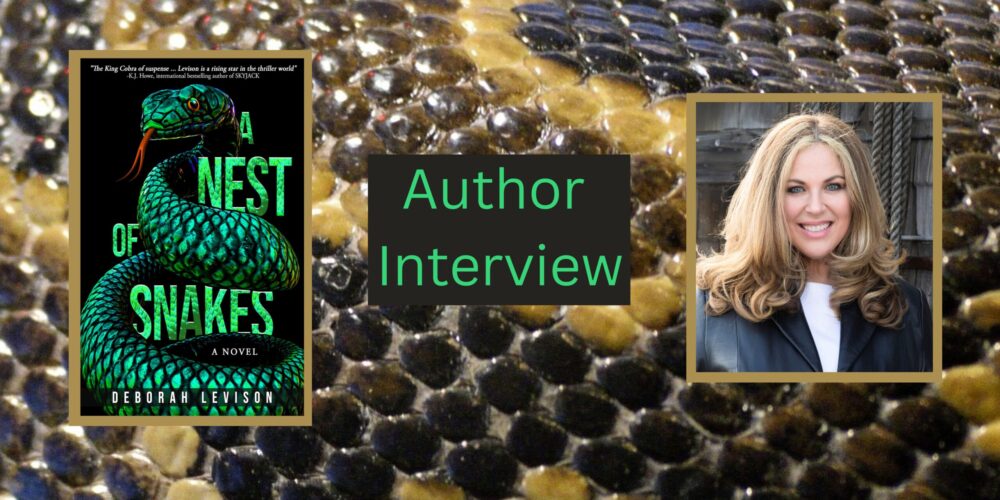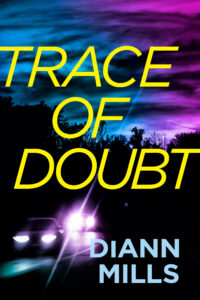A Nest of Snakes, debut novel by Deborah Levison
Author Interview + Book & Author Info + Author Pet Corner!
Don’t miss any Author Interviews! Click the link here.
A Nest of Snakes
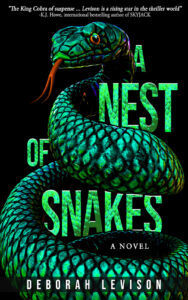 Brendan Cortland is a broken man. Middle-aged, pasty, pudgy, and fearful, he suffers from chronic depression, nightmares, and agoraphobia. His contact with the outside world is limited to trolling chatrooms, where he hunts pedophiles, and a weekly session with his psychiatrist, to whom he describes dreams of being devoured by predators. The doctor suspects catastrophic abuse, and maybe something more; but in all his years of therapy Brendan never divulged the deepest source of his trauma.
Brendan Cortland is a broken man. Middle-aged, pasty, pudgy, and fearful, he suffers from chronic depression, nightmares, and agoraphobia. His contact with the outside world is limited to trolling chatrooms, where he hunts pedophiles, and a weekly session with his psychiatrist, to whom he describes dreams of being devoured by predators. The doctor suspects catastrophic abuse, and maybe something more; but in all his years of therapy Brendan never divulged the deepest source of his trauma.
Pushed to his breaking point, Brendan embarks on a quest for justice. It’s the terrifying step he’s avoided for decades: going public with his story. His lawyer warns him that testifying might mean dredging up painful memories, ones he’d rather keep buried.
Still, no one is prepared for the horrible secrets and revelations that emerge during the trial … least of all Brendan himself.
Reviewers call A NEST OF SNAKES “heart wrenching,” “raw and compelling,” “unforgettable,” and “a roller-coaster ride of surprising twists” leading to a “staggering climax” and an “absolutely perfect” ending. Monster Librarian hails A NEST OF SNAKES as one of the fall’s most talked-about novels.
To purchase A Nest of Snakes, click on any of the following links: Amazon, Barnes and Noble & IndieBound
A Nest of Snakes — Author Interview with Deborah Levison
Tell us about Brendan Cortland, protagonist for A Nest of Snakes:
When we first meet him, Brendan is a broken man, struggling with chronic depression, nightmares, and agoraphobia. He’s barricaded himself in his Connecticut mansion, surrounded by extravagant and bizarre purchases, and lives a solitary existence with only a surly housekeeper and her son for company.
His contact with the outside world is limited to shopping online and a weekly session with his psychiatrist, to whom he describes terrifying dreams of being devoured by hordes of predators, usually snakes. We learn off the bat, though, that Brendan has become something of a computer whiz and spends a lot of time trolling clandestine chatrooms, hunting pedophiles.
Immediately, we suspect abuse.
The story opens on Brendan’s forty-seventh birthday. He is more despondent than usual because his young son didn’t even call or text. Longing to heal, desperate to feel “normal” in the eyes of his estranged family, Brendan decides to go public with his story and file a lawsuit against the elite New England private school he attended as a boy. But as he preps for trial, Brendan is forced to dredge up the painful memories he kept buried for decades.
I feel very protective of Brendan. He was such an interesting character to write, especially as I majored in psychology, which made the research part fun. I’m cheering for him as he embarks on his quest for justice, and his journey of healing.
A Nest of Snakes is your first novel. What was your publishing journey like for your fiction debut?
Back in my twenties, I itched to write my first novel. While I was on maternity leave with my newborn, I figured I’d write while she napped. Well, she was a really good napper, so I wrote a 120,000-word manuscript and shipped it off to the slush piles of the Big Five.
I received a letter from an editor in return. She said my “narrative and flair for dialogue” were “extraordinarily strong.” She said she was “taking the liberty of showing it around the office.” She said, “I do hope you haven’t been snatched up by another publisher.” (I still have the letter.) Then she listed the edits required and said she’d be happy to take a second look after I made the changes.
What did I do? Nothing. Did I edit accordingly, and resubmit? Nope. I let that manuscript sit on a shelf collecting dust. How stupid could I have been? To be fair, I did have two more babies, and did move from Canada to the States, and did get a bit sidetracked with a new career and a new life.
Still — epic fail.
Years later I realized my dream of becoming an author with my true crime book, The Crate. It was a brutal process, though… I queried and signed with an agent, who got me a great book deal with a New York publisher. I fantasized about lunches at the Plaza Hotel with my acquiring editor. That editor left the publishing house, leaving my book orphaned; they dropped it a year later, on my birthday. The agent and I parted ways, and I had to start from scratch. I found a new agent, and a new book deal with WildBlue Press, who is also publishing A Nest of Snakes.
What drew you to writing about childhood abuse in A Nest of Snakes?
A few years ago, there was a spate of lawsuits in Connecticut, where middle-aged men alleged abuse at the boarding schools they attended as boys.
I read through several complaints and I was just horrified. I couldn’t believe what had happened to these children, how vulnerable they were, how they’d been preyed upon, and how many adults were complicit in the abuse. Literally everyone at the schools knew what was happening and no one intervened. No one reported the abuse, and no one protected the victims. And of course, the abuse wasn’t limited to Connecticut by any means; it happened everywhere, from Horace Mann in New York City, to Exeter in New Hampshire, to Upper Canada College in Toronto, to Dublin, Johannesburg, Sydney.
And it hasn’t stopped.
Just this summer the Crown Prince and Princess of Denmark pulled their 16-year-old son out of his prestigious boarding school amid allegations of rampant abuse to which the leadership turned a blind eye. I just think it is such an important story to tell. And a little part of me is hopeful that the book might actually help someone who has been abused and feels alone.
The Crate, your nonfiction book published in 2018, earned much critical acclaim. Tell us about that project:
Thank you for that!
But really, The Crate is not a book I ever thought I’d write. It’s the true story of a grisly crime that rocked my family. We discovered a wooden crate, nailed tightly shut and hidden underneath our cottage by a lake. Inside was… awful.
The discovery left us reeling. My brother became a murder suspect, my husband and I were totally freaked out, and we had three young kids to shield from the situation. But worse, my elderly parents were traumatized. The discovery dredged up their terrible memories of the Holocaust — of surviving ghettos, death marches, concentration camps.
Those first days after the discovery of the crate were filled with shock and horror and a huge sense of violation. But once police identified the victim, and once we learned the circumstances that led to the crate being found on our property, I realized I could give the victim a voice. I wanted to honor her memory… just as I wanted to preserve my parents’ stories from the Holocaust.
The Crate is a nonfiction (true crime) story, and yet there are lots of overlapping themes between it and A Nest of Snakes. Can you describe a few?
You’re absolutely right – both books share themes, like the oppressive weight of memory, the evil that man is capable of, and how trauma can bubble up from the past and ripple out for generations.
As a daughter of Holocaust survivors, I guess I’m drawn to exploring those themes. In A Nest of Snakes, I also wanted to call out social issues that need attention, like child abuse, bullying, and the machismo culture that still proliferates in our society.
What are you working on now?
I’m a few chapters into a new thriller, but sort of came to an impasse in the plot. I’m not liking the direction the story has taken, so I have to backpedal.
I’m a failed plotter: I buy stacks of neon sticky notes and giant Bristol boards, with every intention of mapping out the entire story… and before I know it, my chapters are taking off in directions I hadn’t intended.
Whichever way this goes, though, I think it will end up being quite dark.
Words of Wisdom for Aspiring Writers:
I think of them as the 5 Ps.
Product. Whether you are traditionally published or self-published, you have to start with a great product, that is, a well-written book that provides value to the reader. That’s true for nonfiction, whether it’s a business book, a self-help, a cookbook, a biography, whatever… it must have informative value.
If it’s fiction, of course it needs entertainment value, but it also needs to be credible. And, if you are self-publishing, the finished product must look professional – polished inside and out. You may want to hire a developmental editor to help the story along, and hire a copy editor to make sure the copy is impeccable. You’ll probably want to shell out for the cover art, too.
Patience. This is so hard! I’ve learned that the process of getting published can be agonizingly slow. On average, traditional publishers can take from nine months to two years to put out a book. Ugh, that’s a long time when you are anxious to get going. Agents, editors, and publishers have their own timelines that don’t necessarily align with yours, so patience, in publishing, sure is a virtue.
Perseverance. How bad do you want it? Dealing with rejection is no picnic, but it helps to realize right off the bat that not everything is going to go your way. Rejection is part and parcel of the publishing industry. So are setbacks that are entirely out of your control. Like a global pandemic, for instance. Keep your eyes on your goals and don’t get derailed by delays, impediments, rejections, and other hurdles.
There are scores of bestselling authors who were repeatedly rejected before publication, or who wrote three, four, five or more different manuscripts before they became an “overnight” success.
Public speaking. It’s probably better that I didn’t realize beforehand that this requirement existed. My fear of public speaking bordered on terror. Little did I know how many author talks and presentations I’d have to give. The really cool thing is I’ve come to enjoy it — the opportunity to connect with readers has been fantastic.
Publicity. Someone told me, “Writing the book is the fun part… marketing it is the hard work.” So true! Fortunately, there are myriad ways to market a book.
Great advice!
Author Pet Corner!


Moose (seven years old, from Ohio) and Gigi (two years old, from Mississippi) are both Aussiedoodles
(Australian shepherds mixed with poodles)
and they’re so smart and affectionate and playful…
they bring so much joy to my family.
I could spend all day talking about them.
Adorable!
Deborah Levison — Author of A Nest of Snakes
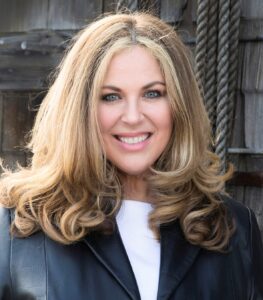
Deborah Levison is an author and publicist. Her life has two parts: the first in Canada, where she attended University of Toronto and the Royal Conservatory of Music, and the second in Connecticut, where she lives with three children, two doodles, and one husband.
Her first book, a nonfiction called The Crate, is a true crime story with echoes of the Holocaust. Reviewers called it “gorgeous and poetic,” “heart-wrenching,” and “a brilliant story.” The Jerusalem Post wrote: “exquisite.” The book won seven literary awards.
Levison’s debut novel, A Nest of Snakes, is part thriller, part courtroom drama based on real-life events. Reviewers call it “raw and compelling,” “unforgettable,” and “a roller-coaster ride of surprising twists leading to a staggering climax and an absolutely perfect ending.” Monster Librarian hails A Nest of Snakes as one of the fall’s most talked-about novels.
To learn more about Deborah, click on any of the following links: Website, Facebook, Instagram & Twitter
Elena Taylor/Elena Hartwell
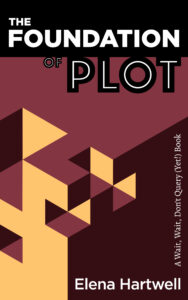
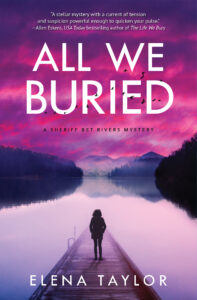 All We Buried, available now in print, e-book, and audio.
All We Buried, available now in print, e-book, and audio.
Silver Falchion Award Finalist, Best Investigator
Foreword INDIE Award Finalist, Best Mystery
The Foundation of Plot, a Wait, Wait, Don’t Query (Yet!) guidebook.
Header image from paulbr75 on Pixabay.

